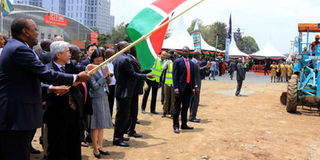Project to fix city’s traffic challenges

President Uhuru Kenyatta flags off the re-construction of Ngong Road on August 24, 2016. The first phase is the 2.5-kilometre stretch from the Kenya National Library Service (KNLS) to Prestige Plaza. PHOTO | JEFF ANGOTE | NATION MEDIA GROUP
What you need to know:
- The three-phase project is partly financed by the Japanese Government though Jica (Japan International Cooperation Agency).
- Its catchment extends to the periurban satellite towns of Ngong, Karen, Kawangware, Riruta Satellite, Kikuyu and Uthiru.
The construction of the first phase of Ngong Road, Nairobi, which is nearing completion, will be a major milestone in efforts to renew and modernise the urban road network.
The project is being implemented as part of the Nairobi Roads Network Improvement Programme for the expansion, rehabilitation and re-carpeting of most roads in the city.
This is critical as Nairobi is a key gateway to the region and window into Kenya, a fast-growing regional commercial and logistics hub.
FUNDING
The three-phase project is partly financed by the Japanese Government though Jica (Japan International Cooperation Agency).
The first phase is the 2.5-kilometre stretch from the Kenya National Library Service (KNLS) to Prestige Plaza, which is set for completion late this year.
The second phase is financed through grant aid from Japan through Jica.
It covers 3.3 kilometres linking Prestige Plaza to Dagoretti Corner, while the third is the Dagoretti Corner-Karen Roundabout, Karen Road Section and the Lang’ata Road section.
DUAL CARRIAGEWAY
It is funded by the government and is expected to be ready in July 2019.
The contractor is already mobilising for commencement of works.
The first phase, which is being built by the World Kaihatsu Kogyo Company Limited at a cost of Sh1.3 billion, involves a number of critical works.
These include a four-lane dual carriageway; three intersections; provision for Non-Motorised Transport in the form of walkways and cycle tracks on both sides; a box culvert; drainage and bus bays.
TRAFFIC
Ngong Road, whose re-construction was launched by President Uhuru Kenyatta in February last year, is unique.
Besides having one of the highest concentrations of vehicular traffic in the country, a factor that has admittedly delayed ongoing works, it also connects a populous and growing catchment area to the city.
As a critical artery, it carries traffic to and from the CBD, and passes through the rapidly growing commercial and residential districts of Upper Hill, Kilimani/Hurlingham, Woodley, Jamhuri and Lavington.
Its catchment extends to the periurban satellite towns of Ngong, Karen, Kawangware, Riruta Satellite, Kikuyu and Uthiru.
BUSINESS
The dualling of Ngong Road will be a boon to the residents of this growing hinterland and the city.
It will de-congest the CBD, reduce travel time by loosening the gridlocks, improve road safety, stimulate socio-economic development and reduce air pollution from many slow-moving vehicles.
While the urban component is being implemented through the Kenya Urban Roads Authority (Kura), the overall national road network improvement is the product of concerted efforts by other agencies under the Department of Infrastructure.
ROAD NETWORK
The agencies are the Kenya Rural Roads Authority (Kerra) and Kenya National Highways Authority (KeNHA).
The Nairobi Roads Network Improvement Programme is part of a strategy to improve the road network.
Already, a number of key projects have been completed and commissioned and their impact is already being felt across the city.
Even then, given the inter-modal nature of transport as an enabler for socio-economic takeoff, the road network being put together by the national government through the triumvirate of agencies - Kura, KenHA and Kerra - can only work if it is part of an efficient, well-maintained and sustainable road network.
COOPERATION
A good artery road will only be as efficient as the smaller feeder roads that supply it with both human and vehicular traffic.
The building and maintenance of an efficient national road network requires concerted efforts by all the relevant authorities and cannot be left to the national government alone. As the Department of Infrastructure and its implementing agencies of Kura, Kerra and KeNHA get down to revitalise a few shortcomings of a national road network previously beset by design inefficiencies, through the adoption of modern, world-class designs, equipment and technology, all hands must be on deck.
COUNTIES
However, it is important that county governments play their part.
For instance, the Nairobi City County government would greatly help the national and city socio-economic development cause by doing its bit, ensuring that the small roads under its jurisdiction, the ones that feed into major arteries like Ngong Road, are in a good, serviceable state.
This project is a challenge to all the other county governments as well to do their bit.
Mr Kinoti is the acting director-general of Kura. [email protected]




